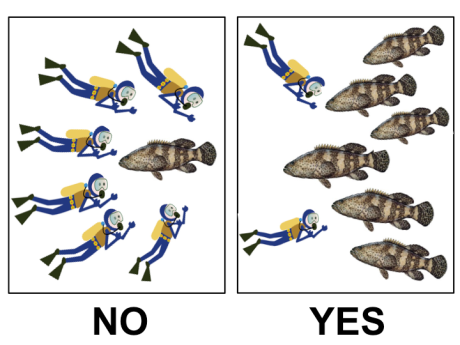My name is Grouper Goodall. I’m a female Goliath Grouper writing a doctoral dissertation on human and grouper behavior. You can read more about my studies here.
During my research, I’ve discovered humans have an inexplicable need to dive with us. It’s true, we, Goliath Groupers, are a sexy bunch. Look at our burly torpedo-shaped bodies and our relaxed poise just hovering around like meditating yogis. We are adorable.
Now during spawning aggregation season (from August to October), we up the ante from adorable to awesome. After all, we’ve waited a whole year to have sex. So we gather at our singles bars, checking out sexy partners (if we can figure out who is the other sex) and we look our best. We call it courtship.

Grouper Goodall and her buddies at a singles bar checking out sexy partners, if they can figure out who is the other sex. Photo Credit: Walt Stearns
During this critical time, your obsession for making us your dive buddies can easily get out of hand. Or fin. You’ll be surprised to know that in our grouper society, we have a code of polite behavior: a grouper etiquette. It has worked for the last 11 million years since the Miocene epoch. We are not going to change our ways, no matter how many selfie sticks you throw at us.
So, for your own good (and ours) I’ll share with you the basics of grouper etiquette.
Consider this an inter-species wake-up call
1) Avoid aggressive diving
We are irresistible, I know. But it’s rude and outright scary for us to see a diver approaching head on at full speed. I mean, when I see such locomotive divers, I pee my pants (If I could wear pants). We don’t follow Euclidean geometry. The shortest distance between you and me is not a straight line, but a soft curve. You should approach me gently, sideways. You’ll be surprised how close you can get to us. Obey this basic first rule of etiquette or you shall only see our tails.
2) Do not block the exit
Always give us a way out. Do you see where my head is? That means, if I decide to swim away from you in a jiffy, I’ll go towards where my head is pointing. So give me space or I might kick you in the gonads in my panic escape.
3) Do not chase after us
You might remember there was once a Jesus guy who said “let the children come to me”. It’s the same with us. You can get close to us, but for a photo portrait kind of close (when you do the citizen science project) don’t chase after us, of we’ll get the hell out of there. We’ll come up to check you out. Look, we are very curious. We like to pop up and ask you “Hello, What’s up? How’s it hanging? But, if you have a hose hanging in there, tuck it in. Come on, be a neat diver and don’t go around steamrolling the corals and the seabed. Not cool.
4) Do not feed us
We’ve worked out the whole year to look this magnificent for spawning season. We’ve done our yoga, eaten all the right foods. Yes, we might look a bit chubby to you but it’s the perfect kind of fat ass. Do you know how difficult it is to keep our spherical beauty? So don’t show up with hot dogs and who knows what. Feeding us breaks our delicate Rubenesque balance.

Remember, avoid aggressive diving, no blocking the exit, no chasing after us, and no giving us food.
I wish you a great diving experience. I’ll be watching you.


